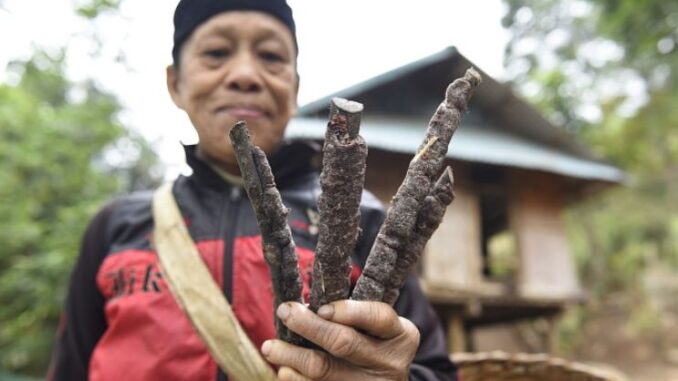
THANH HOA – Many Hmong and Thai families in the border district of Muong Lat are developing red-winged aphid farming for high economic income.
One day in the middle of the week, Mrs. Ha Thi Than, 60 years old, carried a basket up the hillside near her house in Lat village (Tam Chung commune, Muong Lat district) to harvest the ripe peas for red antler sap. She took a sharp knife and carefully tapped each tree trunk as big as a big toe to check before cutting the branches to her liking. More than half an hour, she collected nearly a basket full of red antler tree trunks, brought it back to the yard in front of the house on stilts, peeled it off, and dried it in the sun.
For the past few years, Mrs. Than’s family no longer cultivates corn and grows cassava on a large scale, but spends most of the hill next to the house, nearly a hectare wide, growing lychee trees to raise aphids. “In the past, growing crops was very hard. After hearing that aphid farming was earned, the price was stable, so the family switched to doing this,” said Mrs. Than.

Red ant wing is a red plastic substance secreted by aphids with the scientific name Laccifer lacac Kerr , belonging to the worm family. Plastic is used in the food, pharmaceutical, and polishing industries, especially as an additive in the production of environmentally friendly biodegradable packaging. According to oriental medicine, red ant wing has a bitter taste, cold nature, has the effect of clearing heat, balancing blood, detoxifying, stopping bleeding…
Aphids live on many host trees such as peas, pure grass, alum palm… Ba Than and many people in Muong Lat mainly grow lychee trees due to the suitable climate and soil. Mature beans are 2-3 m high, when the tree grows to the height of an adult’s head, the red leaf aphid begins to be transplanted.
The host plant then reproduces on its own, and the aphids also spread and cover the branches in white patches. The season for releasing aphids is concentrated in April every year. In October, harvest or pillow from the end of the year to summer. Every year, Mrs. Than’s family regularly collects two crops of red ants, selling 30-40 million VND.

Breeding aphids appeared in the border district of Muong Lat in the 90s of the last century. Initially, only a few households were raised, then realizing the value of red ants can help people get out of poverty, the Union of Science and Technology Associations of Thanh Hoa province expanded the area. Up to now, Muong Lat district has more than 50 farming households, in Tam Chung, Trung Ly, Quang Chieu communes, Muong Lat town…
Starting to raise aphids two years ago, Mr. Ha Van Committee’s family (55 years old, in zone 3, Muong Lat town) has converted a part of the land for upland rice and garden land to planting anthill crops. Red. “Working on rice or planting other crops is busy all year round, but it’s only enough to eat, now it’s better to switch to raising red ants but it’s more leisurely…”, Mr. Commissioner said.
Mr. Commissioner calculates an average of 500 m2 of forest land to raise red ants, minus the annual cost of 10-15 million dong, without having to make a big investment or take care of it.
Mr. Tran Van Thang, Head of the Department of Agriculture and Rural Development in Muong Lat district, assessed that red ant farming is one of the occupations that help many local Thai and Hmong families have more income. Due to the mountainous characteristics, complicated terrain and erratic climate, little rain, the farming of red ants also depend on each area.
“The area for planting and raising red ants is currently not much, but it also makes a significant contribution to the people to gradually rise out of poverty,” said Thang, and expects the red ant farming profession here to be expanded.
Follow (vnexpress)
